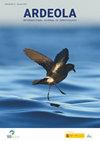母系遗传结构揭示了加那利群岛金丝雀的早期分化
IF 1.2
4区 生物学
Q2 ORNITHOLOGY
引用次数: 5
摘要
总结。加那利群岛的特点是生物多样性突出,有大量的地方性分类群。加那利的鸟类也不例外,现存的六种鸟类被认为是特有的。然而,我们对这些分类群的遗传结构了解有限,这使得很难根据独特谱系的存在来确定保护重点。我们利用细胞色素b和细胞色素氧化酶亚基I两个线粒体基因分析了加那利群岛chffchaff Phylloscopus canariensis的多样化过程和人口统计学。尽管该物种在更新世早期就定居在加那利群岛,但我们的结果表明,该物种的分化过程与末次极大期平行。来自大加那利岛的切夫查夫是一个独特的谱系,因为在这个岛上发现的单倍型在群岛的其他地方都没有记录。我们的研究结果表明,根据附近岛屿的逐渐殖民化和随后的隔离,存在一个分化过程。人口统计结果显示,在大加那利岛(大约1.5万年前)被殖民之前,切夫革的种群数量一直保持稳定的趋势,在大加那利岛,该物种的有效种群规模显著增加。目前,加那利群岛切夫革的有效种群规模是稳定的,这突出了切夫革适应与人类活动有关的局部干扰的能力。总的来说,我们的研究结果提供了加那利群岛切夫革的早期分化情景,重要的是,再次强调了大加那利岛在推动该群岛物种形成过程中的作用。-Illera, j.c., Ramírez, A., Rodríguez, L., Polypathellis, K. & psamez - tris, J.(2020)。母系遗传结构揭示了加那利群岛金丝雀的早期分化。中国生物医学工程学报,17(6):441 -414。本文章由计算机程序翻译,如有差异,请以英文原文为准。
Maternal Genetic Structure Reveals an Incipient Differentiation in the Canary Islands Chiffchaff Phylloscopus canariensis
Summary. The Canary Islands are characterised by an outstanding level of biodiversity with a high number of endemic taxa. The Canarian avifauna is no exception and six extant avian species are recognised as endemic. However, we have a limited understanding of the genetic structure of these taxa, which makes it difficult to identify conservation priorities based on the existence of unique lineages. we analysed the diversification process and demography of the Canary Islands Chiffchaff Phylloscopus canariensis using two mitochondrial genes (cytochrome b and cytochrome oxidase subunit I). Although the species colonised the Canary Islands during the early Pleistocene, our results suggest a recent process of differentiation, which ran in parallel to the Last Glacial Maximum. Chiffchaffs from Gran Canaria emerge as a unique lineage since none of the haplotypes found on this island were recorded anywhere else in the archipelago. Our findings suggest a process of divergence according to the gradual colonisation and subsequent isolation of nearby islands. Demographic results show a stable trend of Chiffchaff populations until the colonisation of Gran Canaria (ca. 15,000 years ago), where the species significantly increased its effective population size. Nowadays, the effective population size of the Canary Islands Chiffchaff is stable, which highlights the ability of Chiffchaffs to adapt to local disturbances related to human activities. Overall, our results provide a scenario of incipient differentiation of the Canary Islands Chiffchaff and, importantly, underscore once more the role of Gran Canaria in driving speciation processes in this archipelago.—Illera, J.C., Ramírez, A., Rodríguez, L., Polypathellis, K. & Pérez-Tris, J. (2020). Maternal genetic structure reveals an incipient differentiation in the Canary Islands Chiffchaff Phylloscopus canariensis. Ardeola, 67: 401-414.
求助全文
通过发布文献求助,成功后即可免费获取论文全文。
去求助
来源期刊
CiteScore
2.30
自引率
6.20%
发文量
16
审稿时长
>12 weeks
期刊介绍:
Ardeola: International Journal of Ornithology is the scientific journal of SEO/BirdLife, the Spanish Ornithological Society. The journal had a regional focus when it was first published, in 1954. Since then, and particular during the past two decades, the journal has expanded its thematic and geographical scope. It is now a fully international forum for research on all aspects of ornithology. We thus welcome studies within the fields of basic biology, ecology, behaviour, conservation and biogeography, especially those arising from hypothesis-based research. Although we have a long publication history of Mediterranean and Neotropical studies, we accept papers on investigations worldwide.
Each volume of Ardeola has two parts, published annually in January and July. The main body of each issue comprises full-length original articles (Papersand Review articles) and shorter notes on methodology or stimulating findings (Short Communications). The publication language is English, with summaries, figure legends and table captions also in Spanish. Ardeolaalso publishes critical Book Reviewsand PhD-Dissertation Summaries; summarising ornithological theses defended in Spain. Finally there are two Spanish-language sections, Ornithological News; summarising significant recent observations of birds in Spain, and Observations of Rare Birds in Spain, the annual reports of the Spanish Rarities Committee.

 求助内容:
求助内容: 应助结果提醒方式:
应助结果提醒方式:


